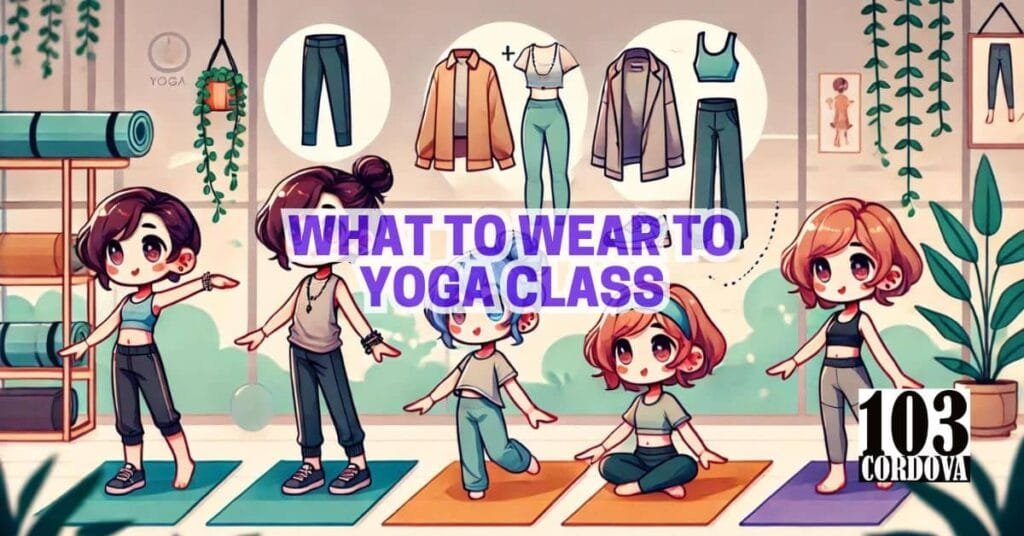Starting yoga can feel new and sometimes confusing, and many beginners are unsure about what to wear to yoga class.
Wearing the right clothing makes it easier to move, stretch, and stay focused during each pose.
The best yoga clothes are comfortable, allow your body to bend freely, and help you manage heat and sweat.
Choosing outfits that fit well and match the type of yoga you practice can also boost your confidence.
We’ll show you simple and useful tips on what to wear to yoga class so you can enjoy your practice from the very beginning.
1. Choose Breathable Fabrics for Comfort During Yoga
Yoga often involves extended periods of movement, which can make you sweat, especially in more intense classes.
Breathable fabrics like cotton, bamboo, or synthetic blends with moisture-wicking properties will help keep you cool.
These materials allow air to flow and sweat to evaporate, making you feel more comfortable throughout your session.
Avoid thick, heavy fabrics that trap heat, as they can cause discomfort and limit your focus.
Selecting lightweight, breathable clothing ensures that your body stays cool and dry, even during the most challenging poses.
🧘 What is Kriya Yoga? How It Compares to Other Yoga Practices
2. Opt for Stretchy Clothing to Enhance Movement
Yoga includes many poses that require your body to bend, twist, and reach in different ways.
Wearing stretchy fabrics like spandex or elastane lets your apparel move with your body instead of holding it back.
A yoga top made from flexible material can help you stay comfortable during arm stretches or balance poses.
Tight or stiff clothing can limit your range of motion, making it harder to practice yoga with ease.
Yoga pants, leggings, and fitted tops designed with stretch give you the freedom to move smoothly from one pose to the next.
Always test your yoga outfit by doing a few simple stretches to check if it stays in place and feels supportive.
Choosing flexible apparel ensures you can focus on your breathing and movements instead of adjusting your clothes.
🧘 How to Choose Between Vinyasa Vs Yin Yoga for Your Fitness Goals
3. Avoid Baggy Clothes That Hinder Your Practice
While loose clothes may seem like a comfortable option, they can interfere with your yoga movements.
During poses like Downward Dog, baggy tops can ride up, distracting you from your practice.
Similarly, wide-leg pants may bunch up or catch underfoot, making it harder to maintain proper form.
Instead, choose fitted or semi-fitted clothing that stays in place as you move through different poses.
This allows you to focus on your form and breathing rather than constantly adjusting your outfit.
🧘 Hot Yoga Vs Regular Yoga: Which One is Right for You?
4. The Importance of a Supportive Sports Bra for Women
For women, a supportive sports bra is an essential part of yoga attire.
Even though yoga may not seem as high-impact as other exercises, many styles involve dynamic movements, inversions, and positions where support is crucial.
A good sports bra helps keep you comfortable, prevents unnecessary movement, and provides security during poses that require balance.
Look for bras with medium to high support that fit snugly but don’t restrict your range of motion or breathing.
A well-chosen sports bra will allow you to focus on your practice rather than adjusting your clothing.
🧘 Ashtanga Yoga Vs. Vinyasa Yoga: Key Differences and Benefits Explained

5. Footwear: To Wear or Not to Wear Shoes in Yoga
Most yoga classes are done barefoot because it helps improve balance and gives you a stronger connection to the yoga mat.
Practicing without shoes also allows your toes and arches to spread naturally, which supports better alignment in standing poses.
Some people choose yoga socks with grips if they want extra traction or are worried about germs on shared studio floors.
Regular shoes are not recommended because they limit how your feet flex and make it harder to adjust smoothly during practice.
If your feet get cold or you prefer more protection, grippy socks can be a good alternative that still lets you feel stable.
For most people, staying barefoot on the yoga mat provides the best comfort and control during class.
🧘 Why Chair Yoga Training Is Essential for Office Workers
6. Find the Right Fit: Balance Comfort and Style
Finding clothing that fits well is key to having a positive yoga experience.
Clothing that is too tight can restrict your movement, while those that is too loose may cause distractions.
Aim for a balance of comfort and style by choosing well-fitted pieces that complement your body and allow you to move freely.
Clothing that is stylish but functional can also boost your confidence, making you feel more at ease in a group setting.
Whether it’s leggings, tops, or sports bras, make sure your outfit fits properly to avoid constant readjustments during class.
🧘 Why Somatic Yoga Training is a Game Changer for Stress Relief
7. Choose Colors That Manage Sweat Well
Light-colored clothes can show sweat marks during yoga, especially in warm or active classes.
This can make beginners feel distracted or less confident.
Darker colors or patterned fabrics often hide sweat better and help you feel more at ease.
Choosing the right colors can also reduce the worry of sweat stains showing during movement.
Picking clothing with colors that manage sweat well allows you to stay focused on your practice instead of your outfit.
🧘 Can Heated Vinyasa Yoga Help You Lose Weight Effectively?
8. Layer Up: Adjust to Temperature Changes with Ease
Yoga studio temperatures can fluctuate, especially during warm-ups and cool-downs, so layering is a smart strategy.
Start with a light layer, like a tank top or a fitted shirt, and add a long-sleeve top or hoodie that you can remove as you warm up.
Wearing layers ensures you stay comfortable at the beginning of class when it’s cooler and can easily adjust as your body temperature rises.
After class, when you cool down, having an extra layer handy will help you stay warm.
Lightweight, easy-to-remove layers are ideal for regulating body temperature without disrupting your practice.
🧘 How to Learn Aerial Yoga Poses Names for a Better Practice
9. Consider Your Yoga Style When Choosing Outfits
The type of yoga you practice can influence what clothing works best for you.
For example, hot yoga classes often require moisture-wicking, lightweight fabrics to keep you cool and dry during intense sessions.
In contrast, restorative or Yin yoga, which involves slower movements, may allow for looser, more comfortable clothing like flowy tops or sweatpants.
If you’re doing more active styles like Vinyasa or Power Yoga, you’ll want form-fitting attire to stay in place during rapid transitions between poses.
Matching your outfit to your yoga style ensures both comfort and practicality in class.
🧘 Exploring the Benefits of Meditation and Yoga
10. Accessorize Wisely: Keep It Simple and Practical
When it comes to yoga accessories, simplicity is key.
Avoid wearing jewelry or watches that can interfere with your practice by getting in the way during poses or causing discomfort.
Practical accessories, such as a headband to keep your hair out of your face or a yoga towel for wiping sweat, are useful without being distracting.
Over-accessorizing can detract from your focus, so stick to essentials that support your practice.
Keeping your accessories minimal and functional helps you stay present and fully engaged in your session.
🧘 Surprising Benefits of Yoga for Health You Need to Know
11. Embrace Your Personal Style to Boost Confidence in Class
Wearing clothing that reflects your personal style can positively impact your confidence in yoga class.
Whether you prefer bold colors, simple designs, or unique patterns, being comfortable in what you wear can help you feel more at ease, among other things.
Choosing pieces that align with your taste allows you to focus more on your practice than on how you look or feel.
While functionality is crucial, expressing your personality through your outfit can bring a sense of joy to your yoga experience.
Feeling good about your attire can boost your overall mood and commitment to your practice.
🧘 Expand Your Knowledge of Yoga
💡 Conclusion
Wearing the right clothing to yoga class helps set you up for success, allowing you to focus fully on your practice.
By choosing breathable, flexible, and well-fitted attire, you can move comfortably through poses without distraction.
For optimal comfort, adjust your outfit based on your yoga style and the studio temperature.
Simple, practical accessories, along with embracing your own style, can also enhance your overall experience.
Being well-prepared with the right outfit lets you concentrate on the true benefits of yoga, mindfulness, movement, and inner peace.
🤝 Our Friends’ Services
Looking for yoga classes that cater to all ages and skill levels?
Join us at 103 Cordova Tower, Marquinton Residences, Cirma Street, Sto. Niño, Marikina City, where we offer inclusive and engaging sessions to help you improve flexibility, strength, and mindfulness.
Whether you’re a beginner or an experienced practitioner, our classes are designed to suit your needs in a supportive environment.
For more information, call us today at 09176225780, use Facebook to get in touch, or use our website’s contact form.
Let us help you start or deepen your yoga journey!
❓ FAQs
1. Can I wear regular workout clothes to a yoga class?
Yes, many regular workout clothes can be worn for yoga as long as they are breathable, stretchy, and not too loose.
Avoid items with thick seams, heavy fabric, or designs that restrict movement.
Clothing meant for running or weight training may work if it allows full flexibility.
Comfort and ease of motion are more important than buying yoga-specific brands.
Always test your clothes by stretching them before class.
2. Do I need special yoga pants, or are leggings enough?
Leggings are often perfect for yoga because they stay in place and move with your body.
Special yoga pants are designed with features like moisture-wicking fabric and flexible waistbands, but they are not required.
Choose leggings that are not see-through when you bend and that give you enough room to stretch.
Avoid pants that slide down or bunch up during poses.
A good pair of leggings or fitted pants is usually all you need.
3. What should men wear to yoga class?
Men can wear lightweight shorts or fitted joggers paired with a breathable T-shirt or tank top.
Stretchy fabrics are best so movements feel natural.
Avoid overly loose shorts since they may ride up in certain poses.
Some men prefer compression shorts under looser shorts for comfort.
The main goal is to wear clothes that stay in place and allow freedom of movement.
4. How should I dress for hot yoga?
Hot yoga makes you sweat a lot, so choose moisture-wicking tops and bottoms that dry quickly.
Many people wear sleeveless tops or sports bras with shorts or cropped leggings.
Darker colors or patterns can help hide sweat marks.
Avoid cotton because it absorbs sweat and becomes heavy.
Light, minimal clothing will keep you cooler and more comfortable in a heated class.
5. Is it okay to wear jewelry or watches during yoga?
It is best to avoid wearing jewelry or watches during yoga.
Necklaces, rings, and bracelets can get in the way of certain poses or cause discomfort.
Watches may press into your wrist or distract you while balancing.
Even small pieces of jewelry can snag on clothing or the mat.
To stay safe and focused, leave accessories off during practice.

